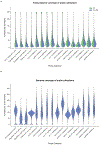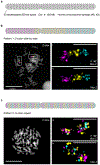PaintSHOP enables the interactive design of transcriptome- and genome-scale oligonucleotide FISH experiments
- PMID: 34226720
- PMCID: PMC8349872
- DOI: 10.1038/s41592-021-01187-3
PaintSHOP enables the interactive design of transcriptome- and genome-scale oligonucleotide FISH experiments
Erratum in
-
Author Correction: PaintSHOP enables the interactive design of transcriptome- and genome-scale oligonucleotide FISH experiments.Nat Methods. 2021 Oct;18(10):1265. doi: 10.1038/s41592-021-01273-6. Nat Methods. 2021. PMID: 34480162 No abstract available.
Abstract
Fluorescence in situ hybridization (FISH) allows researchers to visualize the spatial position and quantity of nucleic acids in fixed samples. Recently, considerable progress has been made in developing oligonucleotide (oligo)-based FISH methods that have enabled researchers to study the three-dimensional organization of the genome at super-resolution and visualize the spatial patterns of gene expression for thousands of genes in individual cells. However, there are few existing computational tools to support the bioinformatics workflows necessary to carry out these experiments using oligo FISH probes. Here, we introduce paint server and homology optimization pipeline (PaintSHOP), an interactive platform for the design of oligo FISH experiments. PaintSHOP enables researchers to identify probes for their experimental targets efficiently, to incorporate additional necessary sequences such as primer pairs and to easily generate files documenting library design. PaintSHOP democratizes and standardizes the process of designing complex probe sets for the oligo FISH community.
© 2021. The Author(s), under exclusive licence to Springer Nature America, Inc.
Conflict of interest statement
Competing Interests
The authors declare no competing interests.
Figures




Similar articles
-
Designing Oligonucleotide-Based FISH Probe Sets with PaintSHOP.Methods Mol Biol. 2024;2784:177-189. doi: 10.1007/978-1-0716-3766-1_12. Methods Mol Biol. 2024. PMID: 38502486 Free PMC article.
-
Fluorescent In Situ Hybridization Using Oligonucleotide-Based Probes.Methods Mol Biol. 2020;2148:71-83. doi: 10.1007/978-1-0716-0623-0_4. Methods Mol Biol. 2020. PMID: 32394375
-
Single Copy Oligonucleotide Fluorescence In Situ Hybridization Probe Design Platforms: Development, Application and Evaluation.Int J Mol Sci. 2021 Jul 1;22(13):7124. doi: 10.3390/ijms22137124. Int J Mol Sci. 2021. PMID: 34281175 Free PMC article. Review.
-
Development and application of oligonucleotide-based chromosome painting for chromosome 4D of Triticum aestivum L.Chromosome Res. 2020 Jun;28(2):171-182. doi: 10.1007/s10577-020-09627-0. Epub 2020 Jan 30. Chromosome Res. 2020. PMID: 32002727
-
Developing novel methods to image and visualize 3D genomes.Cell Biol Toxicol. 2018 Oct;34(5):367-380. doi: 10.1007/s10565-018-9427-z. Epub 2018 Mar 26. Cell Biol Toxicol. 2018. PMID: 29577183 Free PMC article. Review.
Cited by
-
RUNX2 Phase Separation Mediates Long-Range Regulation Between Osteoporosis-Susceptibility Variant and XCR1 to Promote Osteoblast Differentiation.Adv Sci (Weinh). 2025 Feb;12(6):e2413561. doi: 10.1002/advs.202413561. Epub 2024 Dec 20. Adv Sci (Weinh). 2025. PMID: 39704037 Free PMC article.
-
Oligopaint FISH in Drosophila Testes.Methods Mol Biol. 2025;2939:129-139. doi: 10.1007/7651_2025_613. Methods Mol Biol. 2025. PMID: 40172831
-
Tigerfish designs oligonucleotide-based in situ hybridization probes targeting intervals of highly repetitive DNA at the scale of genomes.Nat Commun. 2024 Feb 3;15(1):1027. doi: 10.1038/s41467-024-45385-x. Nat Commun. 2024. PMID: 38310092 Free PMC article.
-
An iron rheostat controls hematopoietic stem cell fate.Cell Stem Cell. 2024 Mar 7;31(3):378-397.e12. doi: 10.1016/j.stem.2024.01.011. Epub 2024 Feb 22. Cell Stem Cell. 2024. PMID: 38402617 Free PMC article.
-
DNA O-MAP uncovers the molecular neighborhoods associated with specific genomic loci.bioRxiv [Preprint]. 2024 Jul 29:2024.07.24.604987. doi: 10.1101/2024.07.24.604987. bioRxiv. 2024. PMID: 39091817 Free PMC article. Preprint.
References
Publication types
MeSH terms
Substances
Grants and funding
LinkOut - more resources
Full Text Sources

